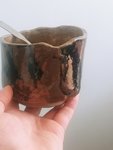jaco94
Chumono
Good morning all,
Could we open a discussion thread dedicated to wabi sabi, this Japanese notion that highlights the beauty of simple, modest and humble things.
It reminds us of the impermanent side of things, the wear and tear of time, imperfection, but also that beauty is very often within reach and that we may not see it ...
A little opposite of a show of force, the goal is on the contrary, to reveal and show the effect of passing time, fragility ...
So let's go ?
Everyone will have to post one or more photos.
I start with these 3 photos taken this morning in my garden.



Could we open a discussion thread dedicated to wabi sabi, this Japanese notion that highlights the beauty of simple, modest and humble things.
It reminds us of the impermanent side of things, the wear and tear of time, imperfection, but also that beauty is very often within reach and that we may not see it ...
A little opposite of a show of force, the goal is on the contrary, to reveal and show the effect of passing time, fragility ...
So let's go ?
Everyone will have to post one or more photos.
I start with these 3 photos taken this morning in my garden.








